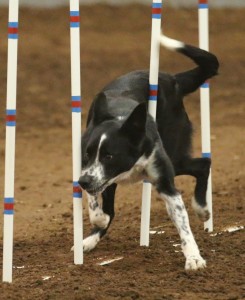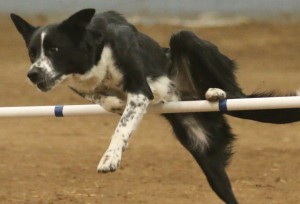Revised April, 2020. Originally published 2015.
My dogs run agility hard, and agility can be hard on dogs. That’s what got me started in canine fitness. Since then I’ve developed canine fitness exercises to also maximize my dog’s performance in Master-level AKC Rally.
I’ve learned to look first for physical causes when a dog knocks bars or avoids obstacles, and I’ve become more proactive about our dogs’ maintenance. An ounce of prevention with the chiropractor, for example, is worth pounds of “cure.”
As I evolved, I researched processes that might take me beyond merely maintaining our canine athletes, toward actually enhancing their physical functioning. I explored ways in which I might empower my dogs to better tolerate the unnatural physical demands our game places on them.
In May 2015, I attended a three-day course in Colorado. Afterward, I completed a complicated case-study process and achieved certification as a FitPaws® Master Trainer. Soon afterward, that course morphed into the “live lab” portion of University of Tennessee’s Certified Canine Fitness Trainer (CCFT) program. In 2018 I completed the online portion of the CCFT program for a more meaningful certification. Since then I’ve enrolled in online and in-person canine fitness courses taught by esteemed gurus of the canine fitness field. I’ve taken meaningful strides in what I hope will be a continuous journey.
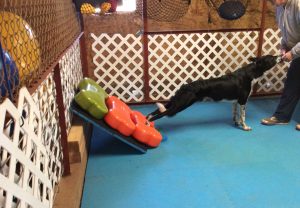
Goals matter! Canine fitness exercises targeting flexibility, for example, are different from exercises focusing on strength.
A blossoming, profitable, canine fitness equipment industry currently receives a lot of attention. Canine exercise equipment is useful and will be discussed. However, as with all tools, it’s not so much what you have as how well you use what you have that gets you where you want to be. If people want to obtain the best (rather than the most) tools, it’s important to determine what those tools are needed for.
Canine Fitness Goals
The purpose of fitness training is to enhance function. Canine sports like agility, fly ball, and freestyle disc routines require dogs to perform (not just run, but perform) full range of motion movements while driving through obstacles. Sports such as obedience and rally require dogs to perform precise movements that require both power and finesse. Fitness training for dogs must address the “function” necessary to safely participate in their handlers’ sports of choice.
Day-to-day functioning goals differ greatly from fitness goals that relate to functioning in competitive sporting events. Exercise programs for canine athletes should begin with slow and controlled movements to maintain correct form and properly engage supportive muscles. Then, progressions enhance functional performance. Progression requires increased demands on stamina and strength resulting from any of the following: increased repetitions or sets, increased tempo, increase in duration (time) static positions are held, and/or use of increasingly difficult equipment. To be effective, progression must include a dog’s continued control of form.
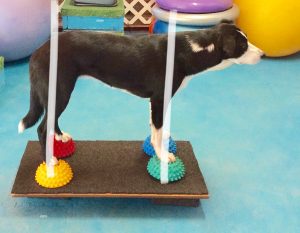
Correct form = legs, back, neck, head – a key consideration for any canine fitness exercise
Fitness Across Planes of Motion
During sporting events, canine athletes use full range of motion and move along multiple planes of direction. Exercises must address muscles and connectors that control and stabilize movements across each plane to prepare dogs for the challenges of each dog’s sport.
Neither humans nor our dogs move only forward or backward, most especially in unpredictable situations when bodies are driving at maximum capacity. Planes can be referred to using other names, and specific movements might be assigned differently, depending on the resource. The words used here are not as important as recognizing and addressing ways in which we require our dogs to use their bodies to move. See videos showing fitness training exercises for dogs across all planes of motion here.
Median Plane – Movements across this plane are generally forward or backward. Most of a dog’s natural movement occurs across this plane. Examples include walking, running, backing, swimming, jumping vertically, downs, sit, and stand.
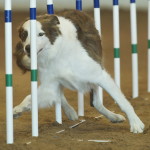
Dorsal or Frontal Plane – Think about limbs moving away from midline (abduction) and back toward midline (adduction). Whether practiced or spontaneous, canine athletes will likely move through this plane. Prepare them!
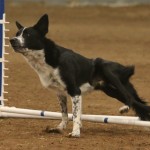
Photo by K. Devine
Transverse Plane – Think about twisting and rotating motions involving the spine. People probably move across this plane more often than our dogs do on an intentional basis.For an under-exercised dog, the introduction to the transverse plane might not occur until the agility dog twists while slipping on a dogwalk or twists in midair while going over a jump.
Specific needs relate to specific activities. Canine athletes should be encouraged to develop the following functional elements of performance to the highest degree possible, as each relates to a specific sport :
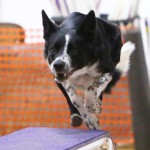
Photo by P. Ensley
Proprioception – the understanding of how an individual’s body is positioned, how the body is moving, awareness of what the limbs are doing- and where. Proprioceptive nerve signals in joints, ligaments, tendons and muscles serve as alerts, improving athletic performance and reducing risk of injury.
Balance—the ability to maintain a body’s position against gravity. Balance must be challenged to improve.
Strength and flexibility – the ability of muscles to move a body with power, allowing full range of motion, without damage. I intentionally listed these two elements together. Both are necessary, yet neither is beneficial to the athlete without the other.
Fitness in Primary vs. Supportive Muscles
Proprioception, balance, strength and flexibility relate to movement. The muscles of movement can most simply be referred to as either primary movers or supporters. You see the bigger bulky primary muscles as a dog moves. Running and jumping activities build these bulky prime movers. These are the muscles people tend to be most aware of.
Supporting muscles are hidden away and easily overlooked in the scheme of canine fitness. These muscles keep an individual together, surrounding every joint and holding the body in position during and after an action has occurred.
Even before focusing on primary movers, handlers should ensure their dogs’ fitness programs include strengthening exercises for supportive muscles to prevent injury and protect joints. In particular, exercise programs should address core muscles – those muscles that stabilize the trunk, spine, and pelvis.
Consider that when a dog flies over a jump or leaps in the air to catch a ball or disc, his prime movers launch him – but his supportive muscles will (hopefully) hold him together when he lands.
One way to engage and strengthen supportive muscles is through the correct use of unstable surfaces. Inflated exercise equipment provides such surfaces wonderfully. I consider the ways in which dogs can learn to use and develop their supportive muscles to be the strongest benefit this kind of equipment offers canine athletes.
It’s important, however, that each dog is worked within the limits of his strength and encouraged to maintain correct form while balancing on equipment. Struggling to maintain balance through large movements or assuming postures that are not natural will not engage supportive muscles.
It’s not enough for the athlete to merely stand on unstable surfaces. Most dogs will eventually achieve balance on almost any commercial stability equipment. Training toward maximum athletic function must also consider progression. This means we teach our dogs to perform increasingly more complex tasks while maintaining balance and correct form on the equipment.
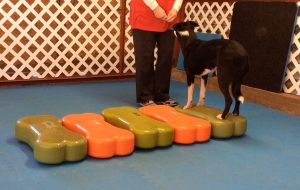
Like the sport of agility, there is much more to the art and science of canine fitness than just “having fun on the equipment.” My purpose for researching and developing canine fitness exercise programs was to strengthen my agility dogs against the extremes of their own nature. Later, when we also competed in AKC Rally, I wanted my dogs to move through position changes and jumps with strength and flexibility.
I believe dedicated attention is required for canine athletes’ supportive muscles that are not called upon regularly. It doesn’t require a gym full of equipment. A couple pieces of the right equipment and a dedicated, knowledgeable handler will be just about perfect. Might that person be you?
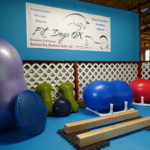
During 2016, renovations to training kennel included a canine fitness room.
My Vimeo Canine Fitness Showcase offers free video insights into fitness training for border collies Rave On and Lincoln.
© 2020 Kris Butler All rights reserved. Sharing link to article allowed but neither text nor photos can be reproduced. Photos licensed to Kris Butler, used with permission. photos feature Butler border collies Lincoln, Rave On, and Yarr.

